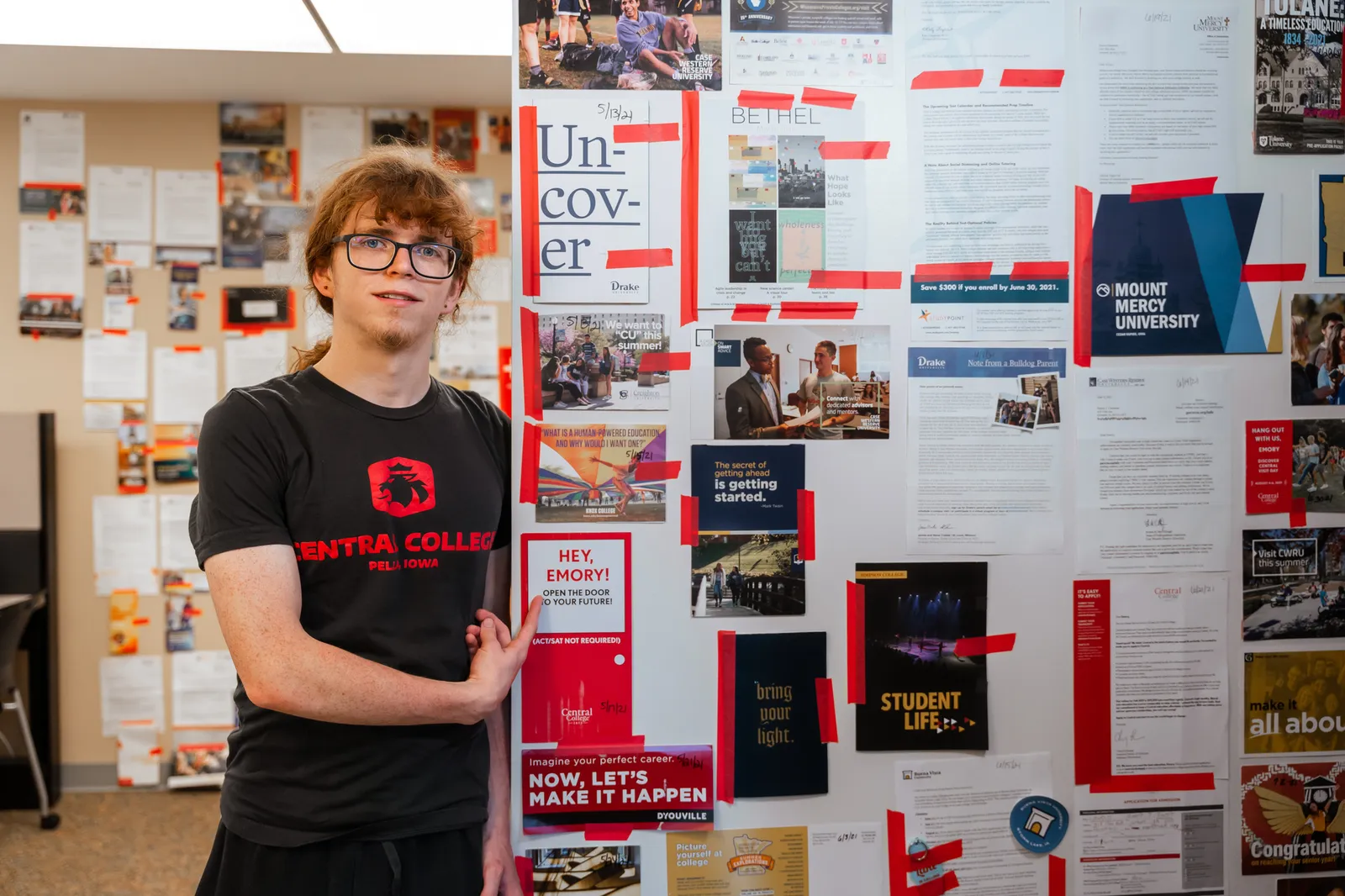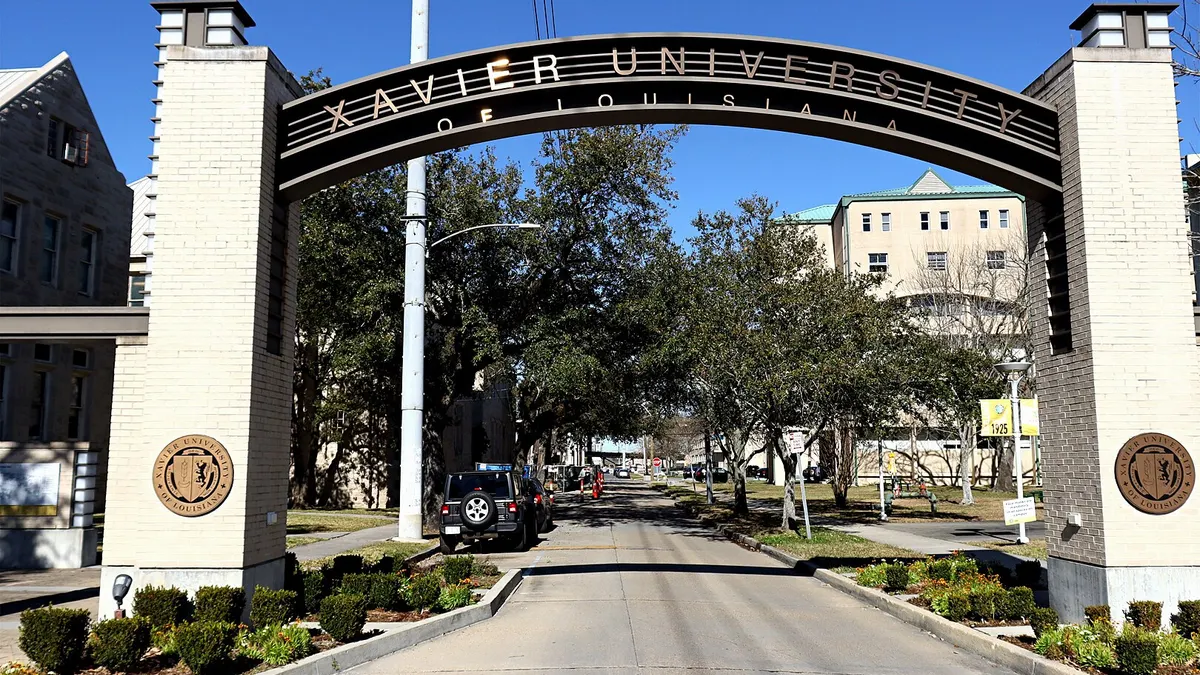Denise Lamphier is the executive director of communications and marketing at Central College in Pella, Iowa. She’s also a proud mom of a first-year college student who happens to be the owner of one yellow flying disc.
This is the first of two columns about her son's college search. The second will appear next week.

For the past four years, I’ve been the mom to a high school student and the director of a busy communications team at Central College.
That alone doesn’t make what I’ve got to share with you unique. Here’s what does: My child, E.J., and I tracked a substantial portion of his college recruitment life together beginning in the summer before he started 9th grade — when he started getting his first recruitment pieces in the mail.
Just after that first piece arrived, I proposed the idea to E.J. to collaborate on a four-year project together, reviewing admission materials. As part of the project, he wrote some journal entries about the mailings. Then I took the pieces to my office at Central and taped them on the wall. This allowed my team to see the four-year progression of materials that a high school student receives from colleges. E.J. also offered me access to his school email account so I could read all the college emails he amassed.

The following statistics reflect his recruitment experience in a numbers nutshell:
One student. Four years. Ninety different colleges and universities. A total of 5,228 emails. Four military recruitment brochures, 23 handwritten notes, 302 postcards, and 162 viewbooks and pamphlets mailed alone. That’s in addition to 130 letters, often including viewbooks, applications or other materials. And we mustn’t forget one yellow flying disc mailed as an irregular parcel.
All to elicit one decision.
It’s no wonder higher education is more competitive and demanding than ever.
What did I learn from watching my child interact with all this content for four years? Well, first of all, friends, we’ve got our work cut out for us.
One thing E.J. and I quickly noticed is that colleges like to market using numbers. Request “5 Signs a College Is Worth It” right now. Or fill out the form below and we’ll send you a free version of “You’re In! 7 Tips to Lock in College Acceptances.”
Five seems to be the number of choice for marketing a college. In that vein, here are five must-have lessons for you to consider as you market your college.
1. Choose your search partners wisely. We really must be careful about which vendors we hire. Some are not helping any college shine. Take, for example, those infamous number campaigns. If a student spends a few minutes answering seven questions, a college will be delighted to mail them an insider’s guide titled “Elevate Your Expectations: 5 Things You Never Knew You Always Wanted.”
I asked E.J. if he would consider filling out a few of these surveys just so I could see these highly sought-after publications. He adamantly refused.
He knew colleges wanted his cell phone number. And, to be clear, it was obvious a vendor was managing these form letters. So much of this content from different colleges featured the same publication names and arrived in the mail at our home on the same day.
“I’m already getting enough mail and email,” E.J. told me. “Why are these places asking me to sign up for more?”
A handful of colleges even wrote “thank you for requesting this publication” letters. He never requested the information. From Feb. 22 of his junior year to March 11, he received 18 letters that all started with “Thank you for requesting …” the pamphlets … that he never requested.
I always wondered if the vendor told the colleges he asked for the publications. If one or two slipped through, that could have been a margin for error. But 18?
2. Personalize the content and keep the lists clean and managed well. One size doesn’t fit all. I saw my kiddo react positively to publications that used his name well.
“Several postcards had my name on it throughout, making me feel a li’l special, as if the ad was intended for me,” E.J. shared.
He also noticed when a college sent:
- Two of the exact same postcards on the same day. (Mind your lists.)
- Virtually the same front cover for six postcards over two years, changing only the visit dates or info on the back. (Saving on design time is not your friend in this scenario.)
- A note telling him he could win a $500 scholarship for Hispanic Heritage Month. “As a white guy, I’m pretty sure I’m not eligible for this.” (Um … yeah.)
Letters were the least reviewed content in our household. They could have said “blah, blah, blah” (and one cheeky letter even did), and E.J. wouldn’t have noticed — totally recyclable material.
3. Leverage your brand. What makes your institution stand out? I can tell you after looking at content that grew to consume about 900 square feet of space on the wall, this is a weak point for many colleges and universities. Sometimes we all look and sound exactly the same.
4. Keep it authentic. And please make your price transparent. As E.J. put it, one college invited him to “discover my purpose and said that college is more than just the cost of tuition — and I knew it was going to be expensive just from that.”
Another sent a flier promising an average out-of-pocket cost of less than $11,000 per year. When I called to get more details, I couldn’t discern just how average E.J. was. The conversation with the admission counselor was like a circle. I never got an answer, only a great deal of “it depends.”
That college got ruled out because pricing transparency and honesty were important to E.J. This is also an example of being sure you offer the best customer service when a student or family member reaches out in response to something you sent. Be ready.
Then there are the colleges that give students money just to visit.
- One college offered $1,000 to visit. “I think they raised their tuition a grand to be able to do that,” E.J. said.
- Another offered $4,000 for visiting and $4,000 for coming from out of state. “That seems like some B.S. scholarships.”
- Yet another extended an offer for a $2,500 scholarship if E.J. visited. “That tells me they added $2,500 to the price of admission and don’t charge it if you come for a visit.”
5. Know your strategy and have a plan. As the marketer mom, I could see from E.J.’s experience when an institution had a plan and when it didn’t.
One college sent E.J. 345 emails and also scored points for sending the highest number of direct mail pieces (28 postcards, three letters and three booklets) during the recruitment process. I couldn’t ever figure out what this college was trying to get across, as the messaging wasn’t at all targeted to my teen — the kid from small-town Iowa, who was in band and tried a few sports in high school, and who didn’t have a clue about a major focus.
Then there were the institutions that sent a single email, or less than five, over the same period without any other omnichannel work. Did you even try? What was the plan here?
At the end of the day, it boils down to this, whether you are sending one email in four years or 345: Are you serving your prospective students well? Or is your content useless and confusing?
To rock it in this world, we must use all the tools — so many tools — all the time and use them well. That single flying disc that came in the mail arrived without a note or a purpose. Was it fun? Yes. My son’s impression? “I think this is such a waste.” Not the response anyone was hoping for.
An important part of a good recruitment strategy is for the admission and communications teams to be synchronized. Not reaching FAFSA filing goals? Change the messaging now. A little shy on a certain targeted demographic? Fine-tune the strategy promptly. Make sure the admission counselors see all the content that is being created so they can use it for every personalized interaction they need to have.
Next week I’ll reveal how E.J. made his college decision and share four more insights for serious marketers.













